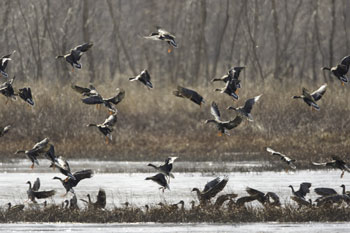
By Dan Zarlenga, Missouri Department of Conservation
Photo Caption: A flock of greater white-fronted geese takes flight in a wetland.
Photo by Noppadol Paothong, Missouri Department of Conservation.
During November the sun’s rule gives way, and the darkness of night claims more and more hours of life’s daily cycle. Listen carefully in that darkness, and overhead it might sound like someone is laughing at you. A group of giggling children perhaps?
What you might actually be hearing is a flock of greater white-fronted geese. They are one of many species of fly-by-night birds.
In daylight, you’d see the upper parts of the greater white-fronted goose are mostly gray or brownish gray and sport black horizontal streaks or splotches. Its legs and bill are pinkish orange. The goose’s calls can be described as yodeling, yelping, or laughing.
These birds are not too common in Missouri, appearing mainly along the state’s western edge, and in sporadic patches throughout, including the St. Louis area. You’re most likely to encounter greater white-fronted geese in marshes, ponds, and lakes, especially if there’s plenty of aquatic vegetation. They can sometimes even be seen in crop fields and pastures looking for grains and roots to eat. It’s also common to find greater white fronted geese mixing with other fellow goose species, like their cousins Canada and snow geese.
The greater white-fronted geese that find their way through the Show-Me-State are migrating between their wintering territory in Mexico, Texas, and Louisiana, and their breeding range in the tundra of Canada’s northern territories and Alaska. And much of that migrating, they do at night.
To be considered fly-by-night is not usually seen as a compliment in human terms, but the tactic is highly common among birds! In fact, it’s believed that the vast majority of birds—from warblers to waterfowl—choose the dark of night for their migratory trips. The sky is quite a busy place for birds after the sun goes down.
But why do birds opt to make these epic journeys in darkness? Just like humans learned thousands of years ago to navigate the sea by using the stars, birds learned the same trick long before that. As they did for ancient mariners, the stars and the moon provide references that point the way for birds through journeys that span thousands of miles. To guide them, the avian travelers rely on instinct as their internal “sextant”.
Flying such long distances requires a lot of energy, and the cooler air temperatures of night reduce the danger of the birds overheating during this intense activity. They can also go further without needing to stop and cool down. Nighttime tends to bring more stable atmosphere with less turbulent air, making it easier for migrating birds to maintain a steady course. Finally, the concealing darkness of night likely makes birds safer from predators. They can concentrate more on traveling without the inconvenience of being eaten, which would certainly ruin the trip! Even though the hours of daylight are becoming precious few this time of year, birds like the greater white-fronted geese find a way to make every hour of life’s daily cycle count. Being “fly-by-night” isn’t a bad thing at all, but rather another example of nature’s marvelous adaptations.


